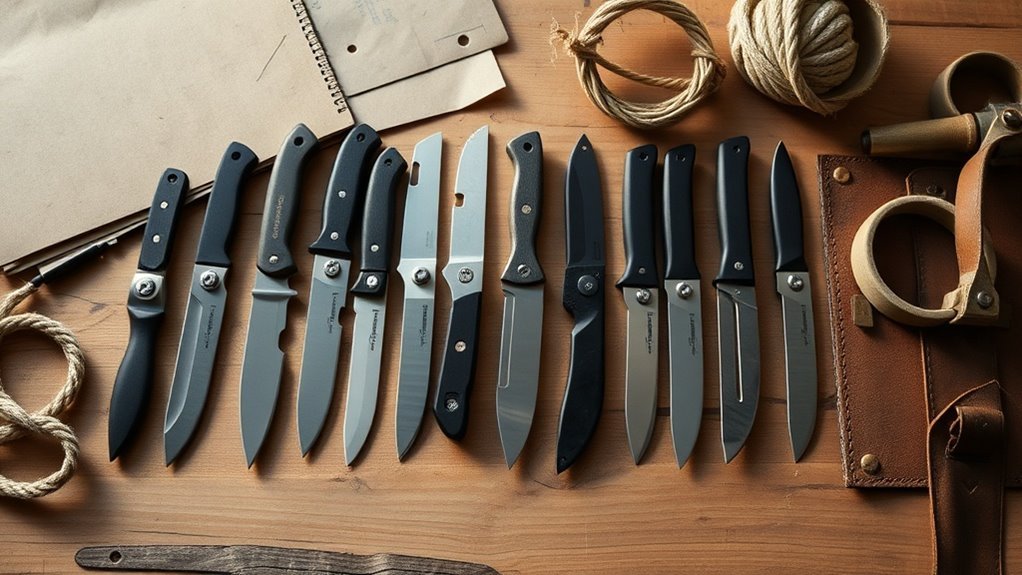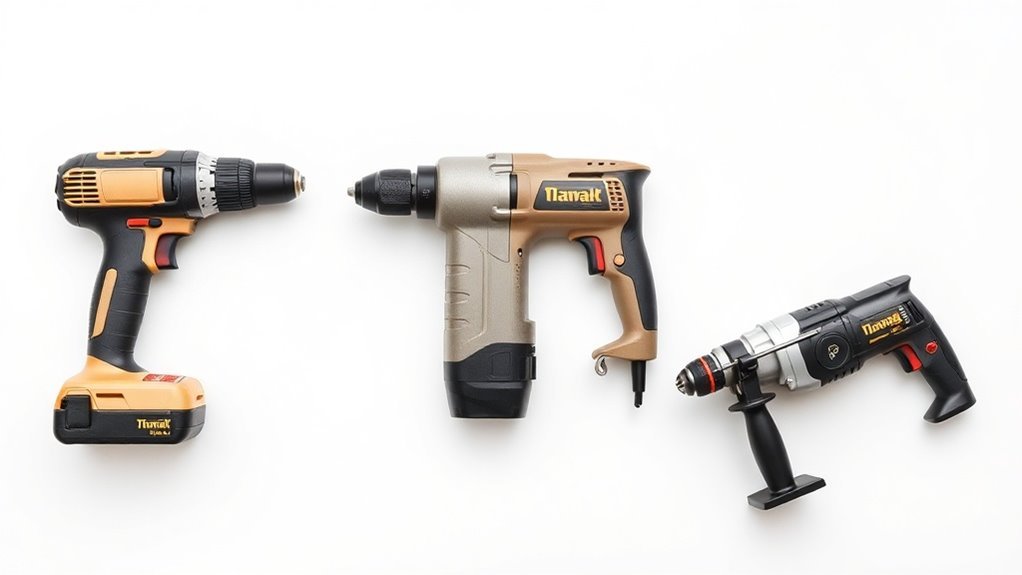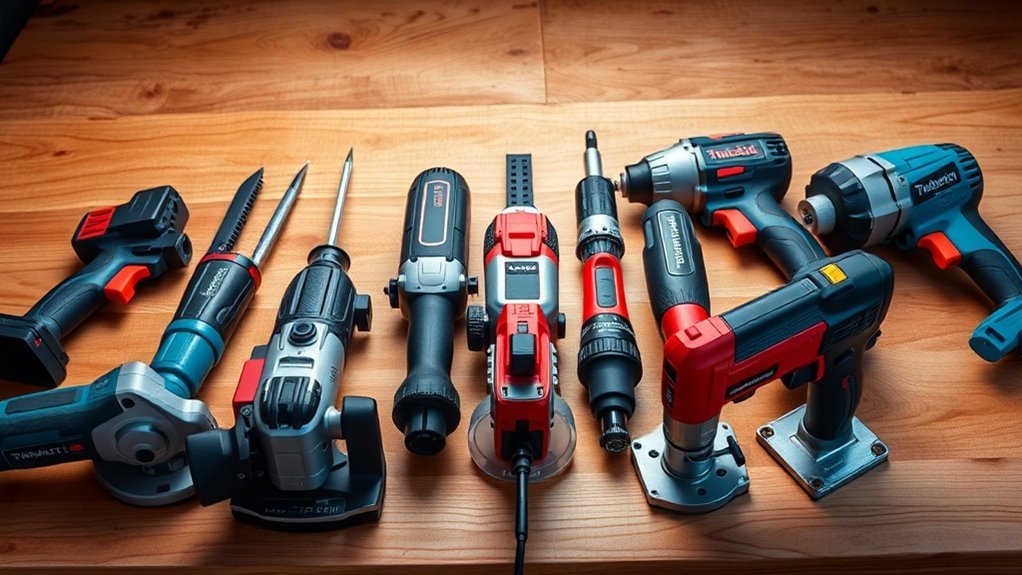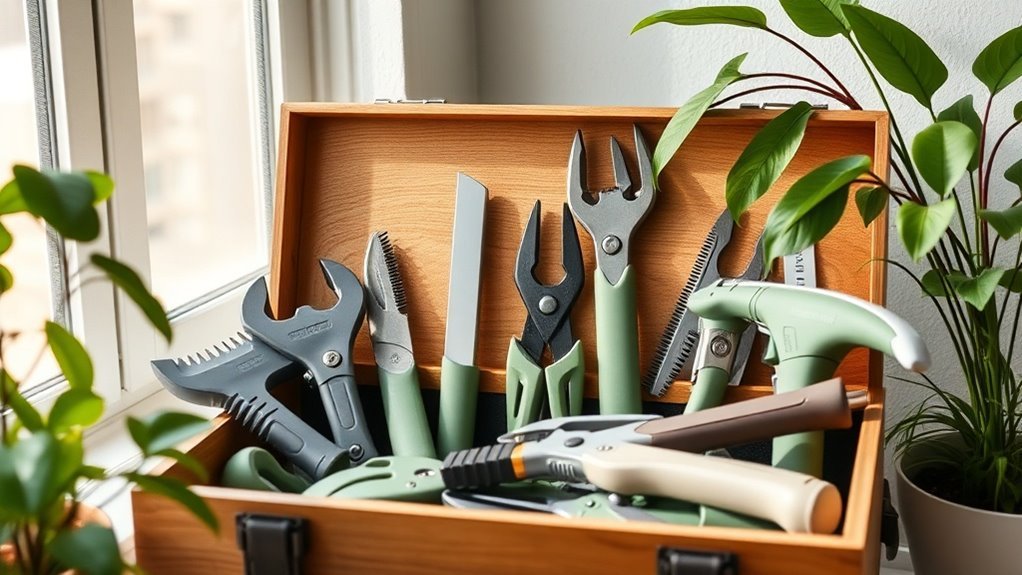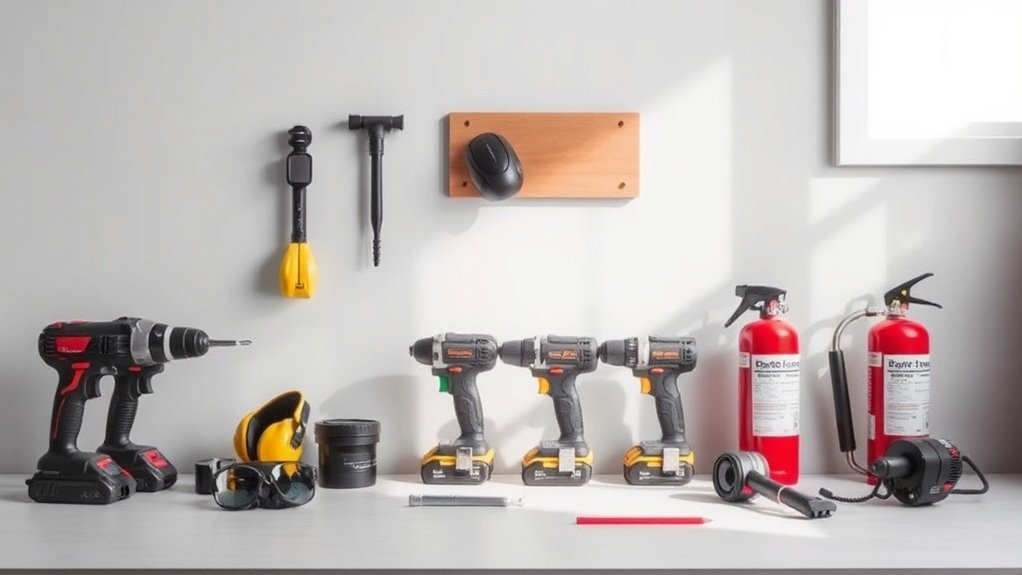How Impact Drivers Work and When to Use Them
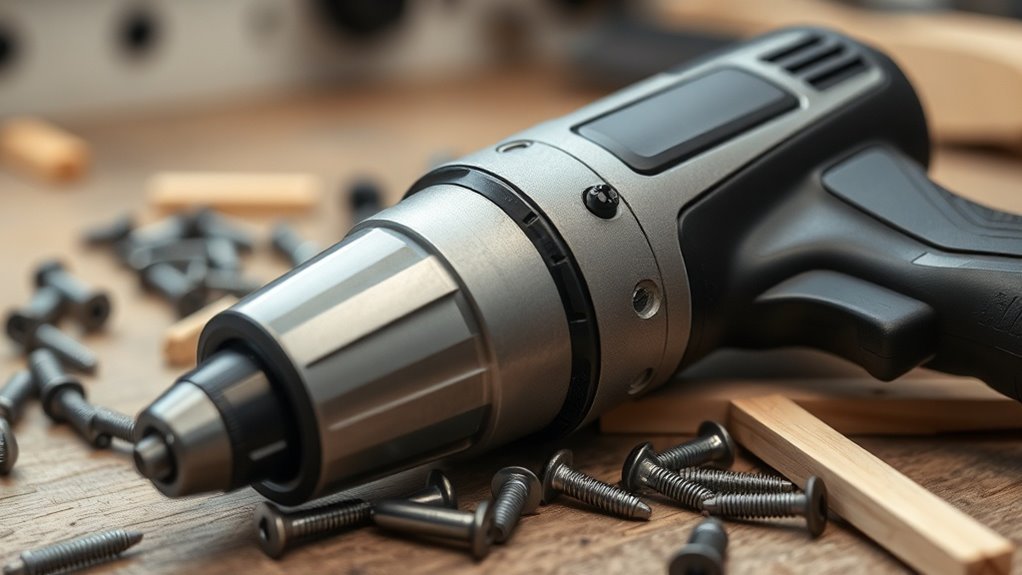
Impact drivers work by combining rotational force with concussive blows to drive screws efficiently, especially into tough materials. They generate high torque with short bursts, making them ideal for driving long screws and loosening stubborn fasteners. You’ll find that their compact design is great for tight spaces, and they operate quieter than traditional drills. If you want to know how to choose the right impact driver and maximize its effectiveness, there’s more to explore!
Key Takeaways
- Impact drivers combine rotational force and concussive blows, increasing torque efficiency for driving screws into tough materials.
- They are ideal for applications like assembling furniture and loosening stubborn fasteners due to their higher torque output.
- These tools operate with short bursts of torque, significantly reducing user fatigue compared to traditional drills.
- Look for features like brushless motors and quick-change chucks to enhance performance and convenience during use.
- Select an impact driver based on required torque, battery life, and compatibility with various bit sizes for your specific tasks.
Understanding the Mechanics of Impact Drivers
Impact drivers are fascinating tools that combine rotational force with concussive blows to drive screws and fasteners efficiently.
At the core of this mechanism, you’ll find an anvil and a powerful hammer. When you pull the trigger, the motor generates rotational speed. As resistance builds from driving a screw, the hammer strikes the anvil, delivering sudden impacts that increase torque without applying more pressure yourself.
This unique combination allows you to work with tougher materials and longer screws without stripping them. You’ll notice that impact drivers often produce less fatigue than traditional drills, which is perfect for extended use. Understanding the specific uses of impact drivers can help you choose the right tool for your projects.
Key Features of Impact Drivers
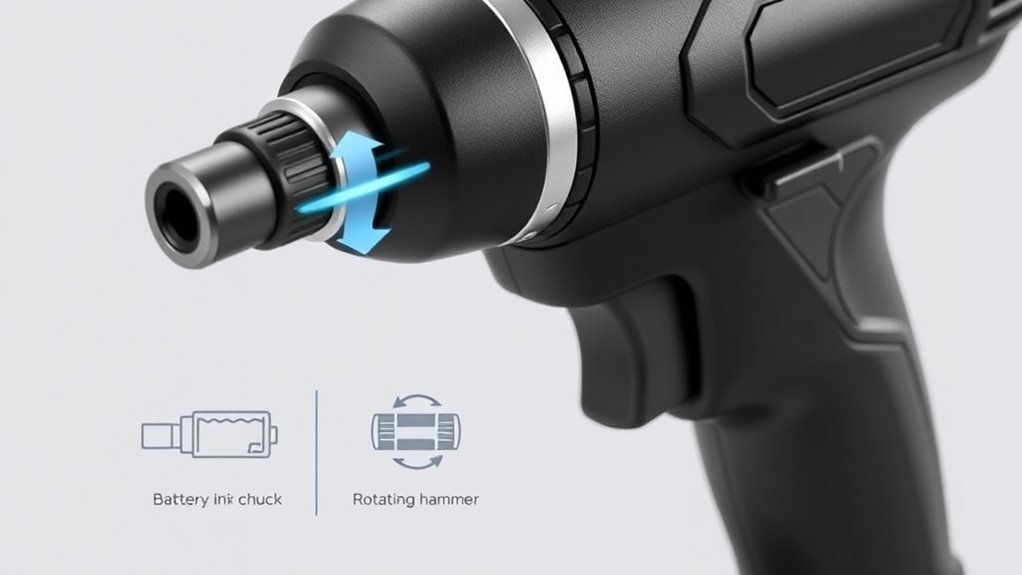
You’ll appreciate the torque generation mechanism that makes driving screws easier and faster. Plus, the compact design offers great advantages for working in tight spaces. Additionally, many modern impact drivers are equipped with brushless motors, which enhance efficiency and extend battery life for improved performance.
Torque Generation Mechanism
While many tools rely solely on continuous rotational force, the torque generation mechanism in impact drivers combines rotational motion with concussive blows to deliver exceptional power and efficiency.
This unique system works by rapidly spinning the bit while simultaneously delivering high-torque impacts. When you pull the trigger, the internal hammer rapidly strikes an anvil, creating a series of short bursts of torque.
Instead of relying on steady pressure, you’ll notice that this method allows you to easily drive long screws or loosen stubborn fasteners without strain. The efficiency of this mechanism helps reduce the chances of stripping screws while maximizing your ability to tackle tough projects.
You’ll appreciate the power and precision it brings to your toolkit.
Compact Design Advantages
A compact design is one of the standout features of impact drivers that makes them essential for both DIY enthusiasts and professionals. This design allows you to fit into tight spaces where traditional drills struggle. Whether you’re working in corners, underneath cabinets, or in other confined areas, you’ll appreciate how easily impact drivers maneuver.
Their lightweight construction also means you can work longer without fatigue, making them perfect for extended projects. Plus, the smaller size doesn’t compromise performance; you still get impressive torque and speed.
You’ll find that a compact impact driver keeps you agile and efficient, allowing you to tackle various tasks with confidence. This combination of portability and power is why people love them for both home and commercial use.
Advantages of Using Impact Drivers
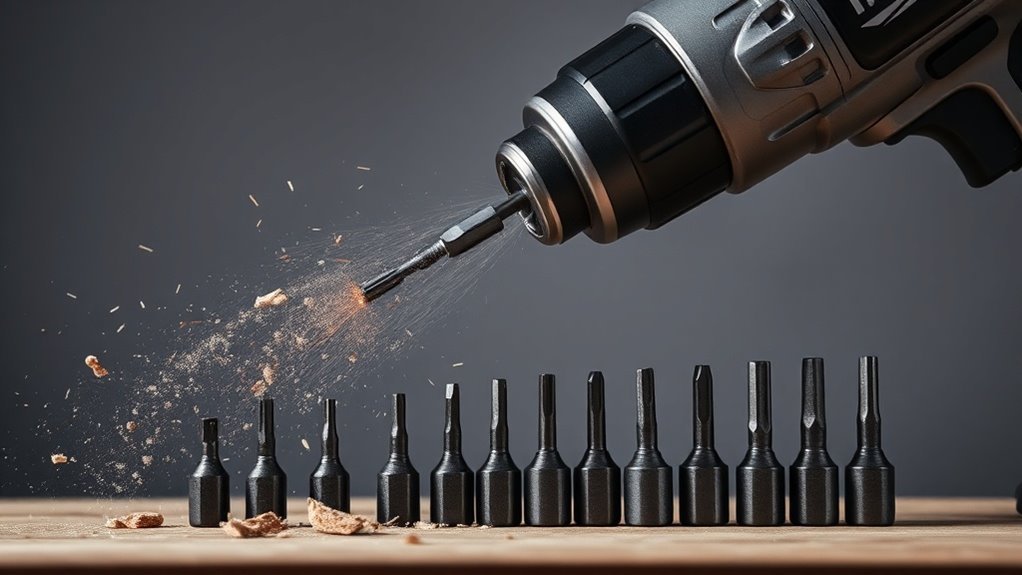
Because they combine torque with speed, impact drivers offer several advantages that make them invaluable tools for both DIY enthusiasts and professionals alike.
One major benefit is their ability to deliver high torque in a compact design, allowing you to tackle tougher jobs without needing excessive force. This not only saves you time but also reduces strain on your wrists and arms.
You’ll also appreciate their versatility, as they excel with various fasteners, making them ideal for multiple tasks.
Plus, impact drivers often run quieter compared to traditional drills, giving you a more pleasant working environment.
Finally, their quick-change chuck means you can switch bits easily, making your workflow even more efficient. Additionally, always remember to wear appropriate safety gear to protect yourself while using power tools, ensuring a safe working environment.
Common Applications for Impact Drivers
Impact drivers are highly effective in a variety of tasks, making them a go-to tool for anyone looking to streamline their projects.
Whether you’re a DIY enthusiast or a professional, you’ll find plenty of uses for this powerful tool.
Here are three common applications where impact drivers shine:
- Driving long screws: The high torque helps you drive screws quickly and efficiently, even into hard materials like wood and metal.
- Removing stubborn fasteners: If you’re dealing with rusted or damaged bolts, an impact driver can make quick work of loosening them.
- Assembling furniture: Impact drivers are perfect for putting together flat-pack furniture, allowing you to finish the job in no time.
Additionally, understanding the relationship among RPM, torque, and speed settings can further enhance the performance of your impact driver for various tasks.
With these capabilities, an impact driver becomes an essential addition to your toolkit.
Differences Between Impact Drivers and Traditional Drills
When you’re choosing between an impact driver and a traditional drill, understanding their differences in power and torque output is key. Impact drivers excel at driving screws into tough materials, while traditional drills are better suited for boring holes. Knowing these distinctions can help you pick the right tool for your projects. Additionally, tooth design considerations for saw blades can help enhance your overall efficiency when performing related tasks.
Power and Torque Output
Power and torque are the driving forces behind any tool, and they play an essential role in distinguishing impact drivers from traditional drills. When you’re choosing between these two, understanding their differences in output is vital.
- Torque Level: Impact drivers typically deliver higher torque than traditional drills, making them ideal for driving long screws or working with dense materials.
- Impact Mechanism: Impact drivers use a unique mechanism that provides bursts of power, allowing you to tackle tough jobs without stalling.
- RPM vs. BPM: While traditional drills focus on revolutions per minute (RPM) for drilling, impact drivers often emphasize blows per minute (BPM), maximizing screw-driving efficiency.
Driving vs. Drilling Functions
Understanding how tools differ in their application is key for effective project execution. While both impact drivers and traditional drills can screw and drill, they serve distinct purposes. An impact driver excels in driving screws with high torque, perfect for fasteners that demand more power. In contrast, traditional drills are designed for drilling holes into various materials. Here’s a quick comparison:
| Feature | Impact Driver |
|---|---|
| Torque Output | High |
| Speed Settings | Usually 1-2 |
| Ideal Use | Driving screws |
| Chuck Type | Hexagonal (1/4”) |
| Drill Functionality | Limited |
Knowing these differences helps you choose the right tool for the job, making your projects more efficient.
Choosing the Right Impact Driver for Your Needs
How do you know which impact driver is right for your projects? Choosing the right one can make all the difference. Here are three key factors to take into account:
Choosing the right impact driver is crucial—consider torque, battery life, and size for your projects!
- Torque Output: Determine the amount of torque you’ll need for your tasks. Heavier-duty jobs require higher torque.
- Battery Life: If you plan on using your impact driver for extended periods, opt for one with a longer battery life or interchangeable batteries to avoid downtime.
- Size and Weight: Depending on the space you’re working in, a more compact, lightweight model may be ideal. It’ll provide better maneuverability and reduce fatigue during prolonged use.
Regular calibration of your tools can significantly impact tool reliability, ensuring accurate performance and enhancing safety in your work environment. Assess these factors to guarantee you pick an impact driver that fits your specific needs!
Tips for Using Impact Drivers Effectively
While you may be excited to start using your impact driver, it’s essential to know a few tips to maximize its effectiveness and guarantee safe operation.
First, always select the right bit for the job; using the wrong size can strip screws or damage materials. Maintain the tool regularly by cleaning it after use and checking for wear and tear on the bits.
Start with a lower torque setting, gradually increasing as needed to prevent stripping or breaking fasteners. Make sure to hold the driver firmly and maintain a straight angle for maximum precision.
Finally, wear safety goggles to protect your eyes from debris, and always keep your work area well-lit and organized to avoid accidents.
Questions
Can I Use an Impact Driver for Drilling Holes?
Yes, you can use an impact driver for drilling holes, but it’s best for driving screws. If you’re drilling, consider using a drill/driver for more control and precision. Always check the bit compatibility first.
How Do I Maintain My Impact Driver?
Oh sure, just let your impact driver gather dust like an old trophy! In reality, clean it regularly, check the brushes, and store it properly. That way, it’ll actually work when you need it.
Are All Impact Drivers Cordless?
Not all impact drivers are cordless; you’ll find both corded and cordless versions available. Cordless models offer greater portability, while corded ones provide consistent power. You should choose based on your specific needs and preferences.
What Accessories Are Compatible With Impact Drivers?
You can use various accessories with impact drivers, like drill bits, socket adapters, and nut drivers. Make sure they have a quarter-inch hex shank for compatibility, ensuring you get the best performance from your tool.
Is It Safe to Use an Impact Driver in Wet Conditions?
It’s not safe to use an impact driver in wet conditions. Moisture can cause electrical hazards and lower tool performance. Always guarantee your work area is dry to protect yourself and prolong your tool’s lifespan.
Conclusion
To sum up, impact drivers are essential tools for anyone tackling tough fastening jobs. Did you know they can deliver up to 3,600 impacts per minute, making them remarkably faster than traditional drills? When you choose the right impact driver and apply the tips shared, you’ll tackle your projects with ease and efficiency. So, whether you’re a DIY enthusiast or a seasoned pro, don’t underestimate the power of an impact driver in your toolkit!


